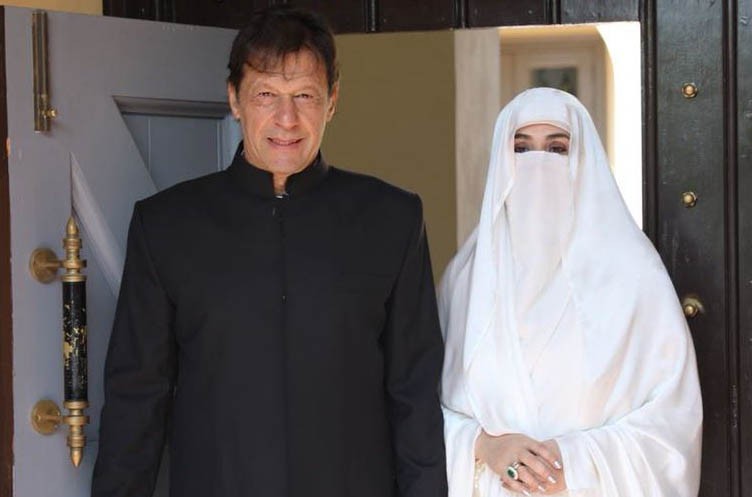
While it remains to be seen what brand of the pious-political tension will define the spirit of Pakistan’s new leadership, there is nothing insignificant or neutral about the first lady’s veil

The full veil observed by the current wife of Prime Minister Imran Khan is not just personal -- it’s a political statement. It represents the first couple’s beliefs, spiritual journey into office, shared political views about Islamic welfare and is a fashion statement, too. These are all relevant to contemporary politics in all Muslim contexts.
Today, the Muslim veil is anything but neutral and nor is it a stable symbol of oppression or domestication. It can be a disciplinary practice, form of mobility and vehicle of political influence. At its core, however, the veil remains a signifier of gender segregation and not gender equality. Ultimately, veil politics benefits the male political elite more than its observers.
Historically, the women’s movement had successfully resisted Gen Ziaul Haq’s attempts to enforce an Islamic dress code on Pakistani women but over the following years, by stealth, the veil has become part of our political optics and pietist social practices.
Bushra Imran’s choice of a full white veil rather than the traditional black burqa is a conscious one, in order to register her social and political class distinction. Some observers are uncomfortable with the PM’s and the first lady’s purposeful and well-accessorised crossing of the dividing line between religion and politics. On the other hand, many of the fickle-minded supporters of General Musharraf’s ‘enlightened moderation’ are today, defending the shrine politics, reputed magic practices, and observation of the face veil by the first lady. All those who worried about and feared the ‘burqa brigades’ of the Jamia Hafsa are today gushing about the ‘grace’ of the first lady’s full veil. Clearly, the veil does not erase class status or our biases.
Other symbols or rituals associated with Islam, such as mosques or animal sacrifice, are not contested much but opinions over the veil remain divided. Some well-meaning commentators argue for neutrality and claim it is simply a wardrobe choice. However, it is not just secularists who reject this effort to dilute the political significance of the veil. Islamists (including women) strongly claim it as a conscious prop to mark their distinct religious and gendered identities and politics.
Gender politics is a valuable currency in building and maintaining an Islamic society. In the absence of iconography in Islam, women become the next best symbols in the quest to establish Muslimness. The question lingers, is Muslim women’s veiling too politically valuable for its practitioners or critics to allow the matter to be resolved?
As the most discussed piece of clothing of recent times, Muslim women’s veils continue to serve as symbolic pieces de resistance, or sites for political point scoring between non-Muslim and Muslim men. Within Muslim contexts, veiling has become a thermometer to measure the liberal and conservative societal temperatures. It also reveals a glaring divide, where Muslim men are custodians and spokesmen of theology, while Muslim women are the ecclesiastical icons who are tasked to promote its politics by wearing (or removing) its symbols.
There has also been the rise of women like Bushra Imran who claim their autonomous choice to veil and become empowered in the name of piety. However, there is no such thing as an empty signifier. The veil, like piety, is always political even when it is a personal choice. Just as we are all products of socialisation, our outward ‘choices’ and appearances are driven by and make a statement in relation to our contexts. The physical veil offers dual functions - as an identity marker, or to conceal one’s self. The discursive concept of purdah can be used as a tool of empowerment, or segregation and invisibility. Clearly, the first lady deploys piety for political ends and there is no mystery about this.
The debate of veil-versus-mini-skirt as a metaphor of regression versus modernity is a false one. Neither item of clothing automatically symbolises oppression or shamelessness. Neither represent a rejection or embrace of femininity and nor are they the costumes of religious extremism or feminism. Women’s clothing causes anxiety to men because they are threatened by or fetishise women’s bodies. Imran Khan’s stated bewilderment at his own decision to marry Bushra without having seen her face is an example of the reification of Islamic gendered relations and preoccupation with women’s modesty.
Men’s opinions over what women choose to do with, or wear on their bodies never bode well for women. Muslim or not, women’s choices to cover or reveal their hair, bodies and political views remains a male obsession and political weapon.
The recent concern over the Muslim (but not Jewish) veil for Boris Johnson led him to objectify Muslim veiled women by equating them to ‘letter-boxes’. Muslim men, who otherwise rarely speak out on other forms of discriminations against women, were quick to defend their right to veil. Both examples of male behaviour reveal men’s own anxieties rather than any interest in women’s choices.
As a chosen form of self-fashioning though, veiling by politically elite women is a significant way of capturing and influencing the bourgeois imaginary. By definition, an Islamic republic is not a neutral state and so, what women wear is always conformist or resistant. It is always political.
While it remains to be seen what brand of the pious-political tension will define the spirit of Pakistan’s new leadership, there is nothing insignificant or neutral about the first lady’s veil.